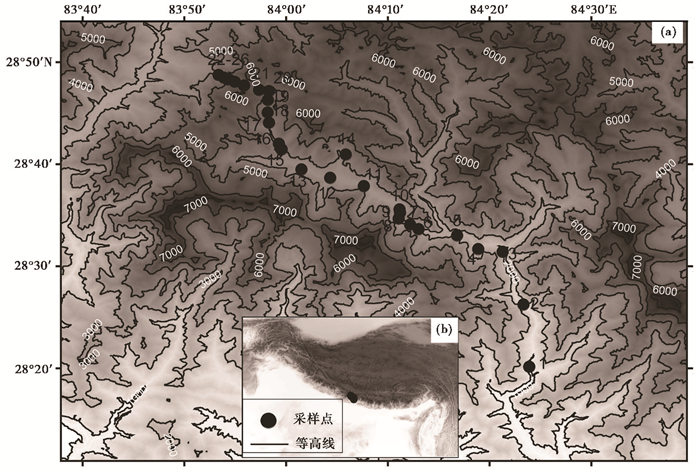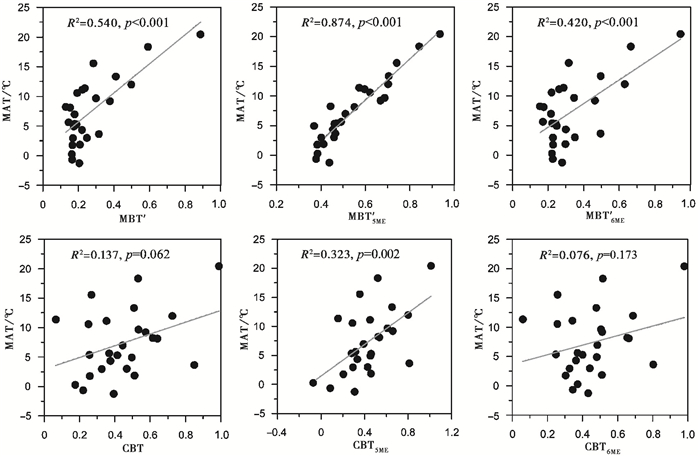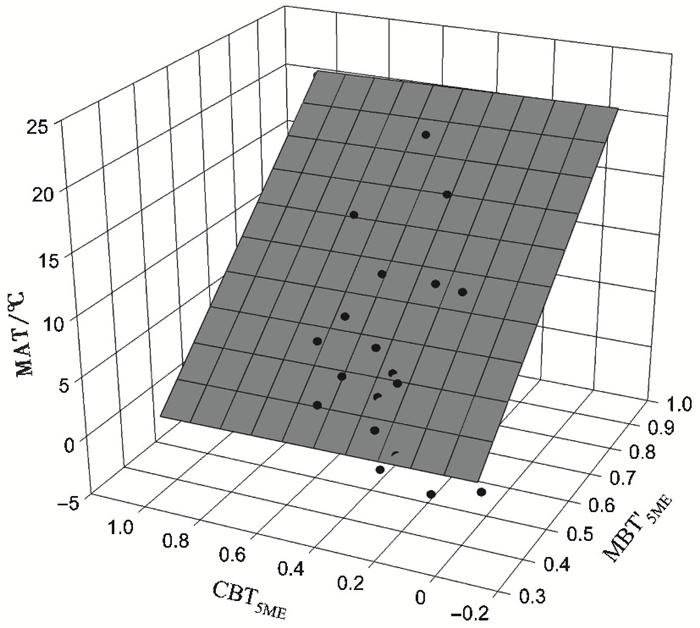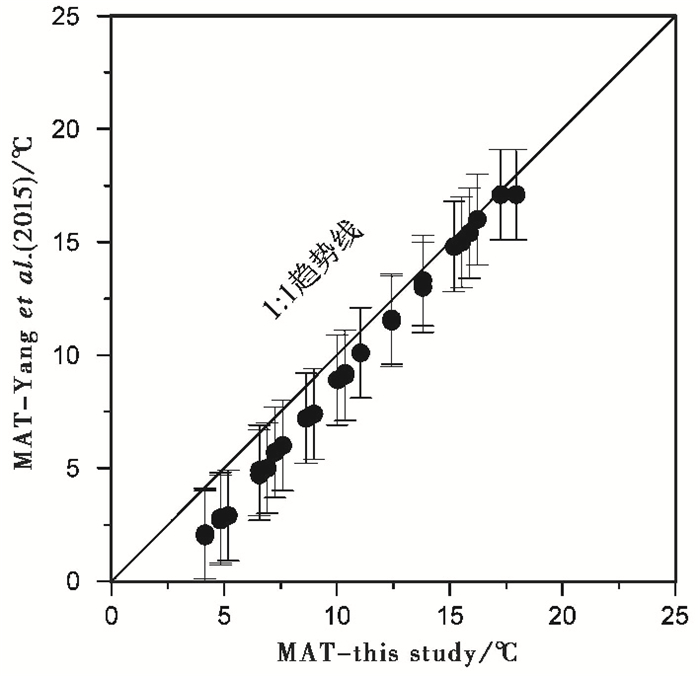② 中国科学院青藏高原研究所, 环境变化与地表过程重点实验室, 北京 100101;
③ 信阳师范学院豫南岩矿宝玉石鉴定及加工中心, 信阳 464000;
④ 中国地质大学(武汉)地球科学学院, 武汉 430074;
⑤ 中国科学院地理科学与资源研究所, 北京 100101)
甘油二烷基甘油四醚脂类化合物(Glycerol dialkyl glycerol tetraethers,简称GDGTs)是微生物细胞膜脂的重要组成部分[1],在记录陆地古气候环境方面有着重要作用[2~4]。GDGTs在自然环境中分布广泛,在土壤[5~7]、泥炭[8~10]、湖泊[3, 11~13]、海洋[14~16]等中均有报道。常见的GDGTs包括类异戊二烯GDGTs(isoprenoid GDGTs,简称iGDGTs)和支链GDGTs(branched GDGTs,简称bGDGTs),分别由古菌和细菌产生[5]。iGDGTs分子中包含数目不等的环戊烷结构,五元环相对数量受古菌生长的温度控制[15, 17]。bGDGTs分子中一般含有2~6个甲基支链和1~2个环戊烷结构,对全球土壤研究发现,bGDGT分子中环戊烷结构数目与土壤pH有关,甲基数目与平均气温(Mean Air Temperature,简称MAT)和土壤pH有关,于是分别建立了反映土壤pH的环化指数(Cyclisation ratio of Branched Tetraethers,简称CBT)和反映MAT及pH的甲基化指数(Methylation index of Branched Tetraethers,简称MBT),剔除pH影响后的MBT/CBT指标可以作为古温度指标[18]。根据甲基位置的不同,bGDGTs同时包含5-甲基bGDGTs和6-甲基bGDGTs同分异构体[19~21]。随着色谱分离技术的改进,5-甲基bGDGTs和6-甲基bGDGTs的分离得以实现[22, 23]。对全球表层土壤的研究发现6-甲基bGDGTs与土壤pH相关,扣除6-甲基bGDGTs,只用5-甲基bGDGTs计算MBT′和CBT,分别表示为MBT′5ME和CBT5ME,MBT′5ME和温度的相关性更高[22]。Yang等[24]基于神农架表土6-甲基bGDGTs定义了新的pH指标IRⅢa′、IRⅡa′,然而该指标在其他地区是否与pH有好的相关性还需要在更多的地区进行探究。
MBT/CBT指标还有可能反映古海拔高度变化,前提是在海拔梯度断面上MBT/CBT指标与MAT有很好的相关关系且MAT在海拔断面上有稳定的气温直减率[24, 25]。对不同地区海拔断面上山地表土GDGTs的研究发现bGDGTs的分布与海拔有很好的相关关系[7, 26~28]。Sinninghe Damsté等[28]对非洲乞力马扎罗山(Mt. Kilimanjaro)海拔断面上16个表土GDGTs的研究发现MBT/CBT指标重建的温度与海拔高度相关性较高(R2=0.77);Peterse等[26]对贡嘎山海拔梯度表层土壤样品GDGTs研究发现MBT/CBT指标重建的温度与海拔高度也有正相关关系(R2=0.55);Liu等[7]对青藏高原东北部橡皮山海拔断面上表土GDGTs研究发现MBT/CBT与海拔高度的相关性(R2=0.64)不如MBT与海拔的相关性高(R2=0.83),这是由于在橡皮山区MBT与pH不相关而CBT与pH高度相关,并认为在某些区域仅用MBT指标就可以恢复古高度(古温度)变化;然而,对中国湖北神农架海拔梯度表土GDGTs研究发现MBT与海拔(或温度)相关性较弱,而MBT/CBT与海拔(或温度)有较好的相关关系[29]。以上的研究结果表明,在不同的环境中MBT对海拔的响应是不同的。为了调查湖北神农架MBT与温度相关性较弱的原因,研究者采用新发展的分离技术分离了5-甲基bGDGTs和6-甲基bGDGTs,发现MBT′5ME与MAT有很好的相关性(R2=0.89)而与pH不相关,MBT′6ME与pH高度相关,表明受pH影响的MBT′6ME是影响MBT与温度相关性的主要因素[24]。但是Liu等[7]对橡皮山的研究中MBT与海拔极高的相关性表明,在橡皮山MBT′6ME似乎没有对MBT与温度相关性造成影响,可能在橡皮山MBT′6ME与温度有关而与pH不相关。
以上的研究表明细菌bGDGTs异构体(5-,6-甲基bGDGTs)在不同海拔梯度环境中的分布及其影响因素还不清楚,需要在全球更多的的高海拔地区进行研究。此外,Yang等[29]对全球8个山地海拔梯度表土bGDGTs与海拔的关系分别进行分析发现MBT/CBT与海拔均有较好的相关性,但是不同地区MBT/CBT指标与海拔之间的转换方程存在很大区别,采用全球或其他地区的转换方程重建的区域温度与实际温度可能会存在较大偏差,因而建立区域转换方程很有必要。
喜马拉雅山和青藏高原的隆升与全球环境变化密切相关,二者的存在不仅加强了亚洲冬、夏季风,而且阻挡了印度洋暖湿气流的北上,加剧了亚洲内陆干旱化[30~32]。喜马拉雅山和青藏高原的古高程定量重建对研究山体隆升过程及其对气候、环境的影响具有重要意义[33, 34]。目前对该区GDGTs指标与海拔关系的研究仅集中在喜马拉雅山以北的青藏高原地区[7, 35],对青藏高原南部的喜马拉雅山区研究还较少。此外,目前bGDGTs异构体(5-,6-甲基bGDGTs)在海拔梯度上与环境因子关系的研究仅在湖北神农架有报道[24],6-甲基异构体对MBT′作为温度(海拔)指标的影响还需要在更多海拔梯度上进行研究。为了进一步探索GDGTs指标作为古(温度)海拔指标的潜能,本文对尼泊尔境内的安纳普娜山海拔梯度表土GDGTs进行研究。安纳普娜山位于青藏高原南缘、喜马拉雅山脉中部南侧,是全球变化的重要敏感区之一。该山海拔梯度(温差梯度)大,水平跨度小,是研究bGDGTs指标与海拔和温度关系的理想地区。本文报道了安纳普娜山海拔梯度上26个表层土壤GDGTs化合物的检出,讨论了5-,6-甲基bGDGTs与温度、pH等环境因子的关系,并建立了bGDGTs指标与MAT的转换方程,为用bGDGTs指标重建此区域的过去温度(高度)研究提供了研究基础。
2 材料与方法 2.1 样品采集安纳普娜山位于尼泊尔北部喜马拉雅山中段南侧(图 1),最高峰海拔高达8091m。受印度季风影响,每年的7月中旬至9月中旬季风降水最多;冬季在海拔3000m以上有降雪[36]。该地区从低海拔到高海拔主要植被类型具有非常显著的垂直分异特征,从松林、灌丛、草原、草甸、稀疏蒿草、流石坡依次过渡到冰川。附近的加德满都气象站(27.7°N,85.367°E;海拔1337m)数据显示,1971~2000年期间年均温度为18.3℃。

|
图 1 采样点地理位置图 Fig. 1 The geographic location of the study region |
2016年10月,本课题组从安纳普娜山底部海拔971m开始至海拔5307m采集表层土壤样品26个(图 1和表 1),经纬度范围为28.34°~28.81°N,83.89°~84.40°E;采样区海拔跨度为4336m,水平距离为40km,是研究GDGTs化合物在海拔梯度变化的理想地点。每个样品采集完后立即装入密封袋密封,标上样号,然后装入白色布袋保存。
| 表 1 样品信息表 Table 1 Sample information of the study region |
所有土壤样品运回实验室立即冷冻干燥,然后用200目筛子筛掉大颗粒的石子和植物根系等杂物,后用陶瓷研钵将土壤样品研磨至80目以下。
2.2 GDGTs前处理和分析利用索式抽提的方法对干燥后土壤样品进行脂类化合物萃取。称取土壤样品约60g,部分样品去除石子和枯枝等杂物后样品量减少至约30g,用体积比为9:1的二氯甲烷与甲醇混合溶剂连续抽提72小时,抽提温度为60℃。将抽提溶液用氮气吹干,转移至20ml样品瓶,加入3~4ml 6 % KOH的MeOH溶液,用振荡器震荡并超声10分钟,静置过夜。之后向样品中加入约1.5ml 5 % NaCl的水溶液,用正己烷萃取中性组分。将萃取的中性组分晾干,用活化的硅胶柱作为固相进行分离,分别用正己烷和甲醇作为洗脱剂样品进行洗脱得到非极性组分和极性组分,GDGTs类化合物在极性组分中。极性组分晾干后溶于正己烷和乙酸乙酯的混合试剂(体积比为84:16),用0.2μm聚四氟乙烯(PTFE)滤膜,除去颗粒物质和大分子化合物,转移至2ml样品瓶中待上机测试
GDGTs化合物的测定在中国科学院青藏高原研究所环境变化与地表过程重点实验室进行。利用HPLC-APCI-MS对样品GDGTs化合物进行分析(仪器型号:Agilent 1200 HPLC+6100 MS)。用3根硅胶柱串联(硅胶柱型号:Hypersil GOLD Silica,100mm×2.1mm,1.9μm)对化合物进行分离。HPLC仪器设置如下:柱温40℃,进样量10μL,流速0.1ml/分钟。流动相中A为正己烷,D为乙酸乙酯,洗脱梯度同Yang等[24]。APCI/MS条件为:雾化器压力60 psi,雾化温度400℃,干燥气流速6L/分钟,温度200℃,毛细管电压(VCap)3500 V,电晕电流5μA。为提高检测信噪比和重现性,采用单离子扫描模式(SIM)对质子化离子[M+H]+进行扫描,扫描质荷比(m/z)为1302、1300、1298、1296、1292、1050、1048、1046、1036、1034、1032、1022、1020和1018。采用外标法确定GDGTs化合物种类,利用手动积分的方式获得GDGTs化合物峰面积,这里假定不同GDGTs化合物对仪器的响应相同,基于峰面积计算得到不同气候代用指标。
本文中bGDGTs各化合物的结构和名称以及MBT′、MBT′5ME、MBT′6ME、CBT、CBT5ME、CBT6ME等指标的计算公式与Yang等[24]保持一致,iGDGTs各化合物结构和名称与Schouten等[1]保持一致。
2.3 环境因子测定对全球土壤的研究发现bGDGTs细胞膜脂在土壤中的分布主要受MAT和pH两个环境因子影响[18, 22]。尽管有研究表明在干旱地区土壤湿度会对MBT(MBT′)指标产生影响[37, 38],但最近的研究表明土壤湿度是通过影响土壤pH从而间接影响bGDGTs的相关指标,土壤湿度本身不会直接影响细菌细胞膜脂的结构和分布[24, 29, 39]。因而本文只对bGDGTs分布起主导作用的MAT和pH两个环境因子进行了分析。
2.3.1 土壤pH测定称取干燥磨碎后的土壤10g,按土水比1:2.5(g:ml)的比例与超纯水混合,混合后用玻璃棒搅拌水土混合液直至均匀,静置半个小时以后,用pH计测定溶液pH。测试前分别用pH=4.00、pH=6.86和pH=9 128的缓冲液对pH计进行校准。测定pH时相邻两次测试之间用超纯水冲洗电极,之后用无尘纸将水吸干。每个样品测定3次,最后的pH取其平均值[40]。
2.3.2 温度数据获取本文使用的各采样点的近地表年均大气温度(MAT)提取自全球气候数据集(WorldClim Data Set)[41]。WorldClim数据集由1950~2000年间全球24542个站点的逐月温度信息和47554个站点的逐月降水信息插值得到,插值计算时经度、纬度和海拔作为独立的变量输入,使得获得特定地点可靠的气候数据成为可能;WorldClim数据集空间分辨率高达1km,可提供逐月的温度、生物气候和高程等数据信息[41]。本研究对采样点的逐月温度及高程数据进行提取,发现个别采样点提取的高程与实测高程存在偏差,可能由于高海拔气象站点较少使得WorldClim数据集对高山地区的信息提取与实际信息存在细小偏差。由于WorldClim数据集提取的温度数据与对应的高程数据存在高度的线性关系(r2=1),我们用实测高程对提取的温度进行校正,得到每个采样点的校正MAT(表 1)。
为了验证WorldClim数据集提取温度的可靠性,我们同时根据研究区的气温直减率估算采样点的年均温度(MATTLR)。Kattel等[42]根据喜马拉雅山中部南测尼泊尔境内56个气象台站(海拔高度在77~3920m之间)20年(1985~2004年)的气象数据计算得到了喜马拉雅山中部南坡山地的年均温度的气温直减率(-0.52℃/100m)。根据此气温直减率估计的MATTLR与WorldClim数据集提取的温度是极为接近的(表 1),说明WorldClim数据集提取的MAT是可靠的。
3 结果 3.1 安纳普娜山海拔梯度上MAT及土壤pH变化本研究采集的26个土壤样品(ANP-1~26)海拔高度从971m至5307m,海拔总跨度达4336m。采样点对应的MAT随海拔升高而降低,从底部的20.43℃降低至顶部的-1.26℃(表 1)。由海拔及MAT变化得出安纳普娜山海拔梯度上的气温直减率为-0.5℃/100m,与Kattel等[42]计算的-0.52℃/100m非常接近。采集的土壤样品pH变化范围为5.95~9.03(表 1),弱酸性土和盐碱性土均有分布。
3.2 GDGTs分布特征在26个土壤样品中均可检测到iGDGTs和bGDGTs化合物。偏酸性土壤以bGDGTs分布为主而偏碱性土壤以iGDGTs分布为主(图 2);iGDGTs分布以GDGT-0和泉古菌醇(Crenarchaeol)为主。

|
图 2 不同pH土壤样品基峰色谱图 (a)ANP-18,pH=6.3;(b)ANP-20,pH=9.03 Fig. 2 Example chromatograms of soil samples with different pH in Annapurna Mountain |
本研究采集的26个土壤样品所含bGDGTs中,Ⅲa、Ⅱa、Ⅱb和Ⅱc化合物的5-甲基bGDGTs的含量低于其同分异构体6-甲图 3基bGDGTs的含量;而Ⅰa和Ⅰb化合物的5-甲基bGDGTs的含量高于其同分异构体6-甲基bGDGTs的含量。Ⅱc和Ⅰc化合物含量相对较低,大部分样品未检测出Ⅲb和Ⅲc化合物(部分样品含量见图 3)。

|
图 3 安纳普娜山地区部分土壤样品bGDGTS组成及分布特征 黑色柱代表 5-甲基bGDGTs,灰色柱代表 6-甲基bGDGTs Fig. 3 Composition and distribution of bGDGTs from different samples in Annapurna Mountain. Black bars represent 5-methyl bGDGTs, gery bars respresent 6-methyl bGDGTs. |
bGDGTs和iGDGTs化合物在土壤样品中的相对分布受pH影响较大(图 2)。我们用HPLC测量获得的iGDGTs化合物峰面积与所有GDGTs化合物峰面积之比来表示iGDGT的相对丰度(f(iGDGTs)),即:

|
(1) |
其中∑(iGDGTs)代表样品中所有iGDGTs的峰面积总和,∑(bGDGTs)代表样品中所有bGDGTs的峰面积总和。结果表明f(iGDGTs)与pH正相关(r2=0.527,n=26,p < 0.001,图 4),随着土壤pH升高,iGDGTs的相对含量升高。杨欢等[40]对中国不同气候带土壤的研究也发现iGDGTs对于bGDGTs的相对含量随着土壤pH升高而逐渐增大;土壤pH在8.0以下时,bGDGTs含量一般较iGDGTs含量高;而在pH大于8.0的盐碱化土壤中,iGDGTs占优势。类似的结果在其他地区的土壤GDGTs调查研究中也得到了证实[5, 18],即iGDGTs的相对含量在碱性环境中更高,可能因为合成iGDGTs的泉古菌更适于生存在弱碱性环境中,而合成bGDGTs的细菌更适于生存在酸性环境中。

|
图 4 iGDGTs相对含量f(iGDGTs)随土壤pH变化图 Fig. 4 Correlation between the relative abundance of iGDGTs(f(iGDGTs))and the soil pH |
由于本研究中大部分样品未检测出Ⅲb和Ⅲc化合物,因此甲基化指数采用不包含Ⅲb和Ⅲc化合物的MBT′指标[43]。
温度和pH是影响MBT、CBT指标的主要因素[18]。然而5-,6-甲基bGDGTs在海拔梯度上对温度与pH等环境因子的响应目前还不清楚[7, 24]。为了研究安纳普娜山表土5-,6-甲基bGDGTs与温度和pH的关系,本文按照Yang等[24]的方法分别计算了MBT′、MBT′5ME、MBT′6ME、CBT、CBT5ME、CBT6ME指标,并分别建立了这些指标与pH和MAT的相关关系(图 5和6)。

|
图 5 bGDGTs指标与土壤pH相关关系图 Fig. 5 Relationships between the bGDGTs proxies and the soil pH |

|
图 6 bGDGTs指标与MAT相关关系图 Fig. 6 Relationships between the bGDGTs proxies and the MAT |
相关分析发现安纳普娜山海拔梯度表土CBT与pH呈弱相关关系(R2=0.399,p < 0.001),CBT5ME与pH相关性较好(R2=0.552,p < 0.001),CBT6ME与pH的相关性较差(R2=0.253,p=0.009),说明CBT5ME受土壤pH影响较大;MBT′与pH有一定的相关关系(R2=0.493,p < 0.001),MBT′5ME与pH相关性较弱(R2=0.374,p < 0.001),MBT′6ME与pH相关性较好(R2=0.565,p < 0.001)。对神农架bGDGTs研究也发现土壤pH与MBT′6ME相关性较好[24],说明MBT′6ME受土壤pH影响较大。
安纳普娜山表土CBT、CBT5ME以及CBT6ME指标与MAT均没有明显的相关性,表明bGDGTs的五元环数目不受温度变化影响;而MBT′5ME与MAT高度相关(R2=0.874,p < 0.001),MBT′与MAT相关性(R2=0.540,p < 0.001)不如MBT′5ME,MBT′6ME与MAT相关性较弱(R2=0.420,p < 0.001)。说明在安纳普娜山地区受pH影响的MBT′6ME削弱了MBT′与MAT的相关性。
对湖北神农架土壤GDGTs的研究也发现6-甲基bGDGTs的存在是造成MBT′指标与MAT相关性较差的主要原因[24],而在橡皮山海拔断面上表土MBT不受pH影响,MBT受海拔控制[7]。橡皮山bGDGTs没有分离5-、6-甲基,即MBT指标包含5-、6-甲基bGDGTs同分异构体,MBT与海拔(温度)的高度相关(R2=0.83)说明在橡皮山6-甲基异构体的存在没有影响到MBT与海拔(温度)的相关性[7]。对比橡皮山、神农架和安纳普娜山地区bGDGTs指标与温度和pH的关系,说明5-、6-甲基异构体在不同的环境中对环境因子的响应不同。当然,也不排除橡皮山bGDGTs中不包含6-甲基bGDGTs或6-甲基bGDGTs含量极低,不影响5-甲基GDGTs与温度的相关性,但这需要进一步研究。对全球土壤的研究发现bGDGTs可能由不同种类的细菌产生[44, 45];很有可能某些环境中的细菌只产生5-甲基bGDGTs而某些环境中的细菌只产生6-甲基bGDGTs[24]。因而在利用MBT(MBT′)、CBT指标重建古环境时需要对特定研究地区的GDGTs指标与环境因子关系进行深入分析,直接套用基于其他地区或全球的转换方程可能会带来较大的误差。
此外,Yang等[24]基于神农架表土6-甲基bGDGTs定义的新的pH指标IRⅢa′、IRⅡa′在安纳普娜地区与pH没有显著的相关性(R2分别为0.36和0.359)。说明在安纳普娜地区IRⅢa′、IRⅡa′不能作为可靠的pH指标。同时也说明了5-、6-甲基bGDGTs在不同的山体环境中对环境因子响应的复杂性和区域性。
4.3 安纳普娜山表土bGDGT与年均气温的转换方程已有研究发现采用全球MBT(MBT′)/CBT方程重建的干旱区碱性土壤的温度比实测温度低[38, 39, 46],采用区域方程重建温度的准确性更高[28, 29, 47]。因而建立区域转换方程是很有必要的。
安纳普娜山地区表土中MBT′5ME与MAT显著相关(R2=0.874,p < 0.001),因此,我们推测在这一地区MBT′5ME可以作为温度变化的代用指标:

|
(3) |
但同时MBT′5ME也受pH影响(图 5),为了弱化pH对MBT′5ME作为温度代用指标的影响,我们还采用MBT′5ME、CBT5ME与MAT建立了另一个转换方程。多元回归线性拟合结果如图 7。

|
(4) |

|
图 7 安纳普娜山海拔梯度表土MBT′5ME、CBT5ME以及MAT多元线性拟合 Fig. 7 Multiple linear regression plot for the MBT′5ME-CBT5ME calibration and MAT on Annapurna Mountain |
为了检验本文建立方程的可靠性,我们应用全球土壤MBT′5ME-MAT的转换方程[22]:

|
(5) |
重建安纳普娜山海拔梯度土壤样品的年均温度变化,并将重建的温度与WorldClim数据集提取的实地温度(MAT)[41]进行对比,发现全球土壤方程重建的温度与提取的温度非常接近(R2=0.874,图 8)。应用本文建立的方程(方程(3)、方程(4))重建的温度与模型所读取的温度也是极为接近的(R2=0.874,图 8),说明本文建立的方程与全球土壤方程(方程(5))均可以用来重建安纳普娜山地区过去的温度变化。但是,全球土壤方程(方程(5))的均方差误差较大(RMSE=4.8℃)。相比之下,本研究在海拔梯度上建立的方程(方程(3)和方程(4))具有较高的R2(R2=0.874)和较小的均方根误差(RMSE=2.0℃),方程重建喜马拉雅山地区温度的准确性可能会更高。而且方程(3)和方程(4)重建的温度值几乎是一致的(图 8),因而都可以作为该区bGDGTs指标与温度的转换方程。由于GDGTs指标在重建温度时采用手动积分的方法,所以在积分过程中难免会存在积分误差,而且bGDGTs指标与MAT的转换方程本身也存在方程误差(RMSE=2.0℃),所以方程重建温度与实际温度会存在偏差。手动积分及方程误差已在图 8中用误差棒标注,在误差范围内,我们认为我们重建的方程是可以反应实测温度值的。本文建立的方程为以后用bGDGTs指标重建该区域过去温度记录提供了基础,由于温度与海拔的相关性,进一步也可以估算该地区过去的古海拔高度。

|
图 8 基于转换方程重建的采样点温度与由WorldClim数据集提取的采样点温度的相关对比图 圆圈以及灰色棒为应用全球土壤方程[22](方程5)重建的年均温度及其误差;正方形及深灰色棒为用本研究建立的多元线性回归方程(方程(4))重建的年均温度及其误差;三角及浅灰色棒为用本研究建立的MBT′5ME-MAT线性回归方程(方程(3))重建的年均温度及其误差 Fig. 8 Regression plot between GDGT-derived MAT and the MAT extracted from the WorldClim data set. Circle and light-grey bars represent MAT reconstructed from the equation of the global soil and its error, square and dark-grey bars represent MAT reconstructed from the multiple linear regression equation established in this study(equation (4))and its error, triangle and light-grey bars represent MAT reconstructed from the MBT′5ME-MAT equation established in this study(equation (3))and its error |
为了进一步对本文建立的转换方程的准确性及适用性进行评估,下文将对本文建立的转方程进行应用。由于目前在海拔梯度上对土壤bGDGTs进行5-、6-甲基同分异构体分离的研究非常稀少,据笔者所知,仅有的研究报道在湖北神农架[24]和安第斯山中南部[46]。但是对安第斯山研究中没有讨论MBT(或MBT′5ME)与温度(或海拔)的关系。因而本文将本研究建立的转换方程(方程(3))应用于湖北神农架,发现在方程误差范围内应用本研究的方程与应用Yang等[24]中建立的转换方程重建的神农架海拔梯度上的MAT是非常接近的(图 9)。进而证实了本研究建立的转换方程的可靠性。

|
图 9 应用本文建立的转换方程重建的湖北神农架海拔梯度MAT与Yang等[24]重建的湖北神农架海拔梯度MAT相关图 Fig. 9 Regression plot showing the MAT reconstructed using the transformation equation established in this paper and that in Yang et al.(2015)[24] from an altitudinal transect at Mount Shennongjia |
安纳普娜山表土MBT′5ME重建MAT与海拔有明显的线性负相关关系,从底部的20.89℃降低到顶部的1.35℃(R2=0.87,p < 0.001)(图 10),说明在安纳普娜山地区MBT′5ME可以用来重建海拔高度。MBT′5ME重建的采样点MAT气温直减率(ΔT=-0.45℃/100m)与由WorldClim数据集提取的采样点MAT气温直减率(ΔT=-0.50℃/100m)[41]、由尼泊尔境内56个气象台站气象数据计算的喜马拉雅山中部南坡气温直减率(ΔT=-0.52℃/100m)[42]以及由青藏高原南部气象台站气象数据计算的高原南部气温直减率(ΔT=-0.48℃/100m)[48]基本一致,均低于全球平均气温直减率(ΔT=-0.65℃/100m)[48]。研究表明气温直减率受相对湿度影响,二者呈反相关关系[48, 49]。研究区位于印度季风影响区,相对湿度较大[36, 42, 48],因而气温直减率相对较低。本研究说明在安纳普娜山地区MBT′5ME指标可以用来重建古(温度)海拔高度。

|
图 10 安纳普娜山海拔梯度上MBT′5ME指标重建的MAT与海拔关系 Fig. 10 Relationships of MBT′5ME-derived MATs with altitude along the Annapurna Mountain |
通过对喜马拉雅山南坡安纳普娜山海拔梯度26个表层土壤样品GDGTs分析,本文得到以下认识:
(1) 安纳普娜山表土中含有bGDGTs和iGDGTs化合物,且表土iGDGTs相对丰度受pH影响,随着土壤pH升高,iGDGTs的相对含量升高。表土bGDGTs化合物中Ⅲa、Ⅱa、Ⅱb和Ⅱc化合物的5-甲基bGDGTs的含量低于其同分异构体6-甲基bGDGTs的含量。
(2) 与环境因子分析表明MBT′6ME受土壤pH影响较大,MBT′5ME与MAT高度相关,6-甲基bGDGTs的存在是造成MBT′指标与MAT相关性较差的主要原因。剔除6-甲基bGDGTs,本文建立了MBT′5ME与MAT以及MBT′5ME-CBT5ME与MAT的转换方程,分别表示为:MAT=-11.396+34.521×MBT′5ME(n=26,R2=0.874,RMSE=2.0℃,p < 0.001)以及MAT =-11.418+34.776×MBT′5ME-0.269×CBT5ME(n=26,R2=0.874,RMSE=2.08℃,p < 0.001)。相比全球土壤方程,本研究建立的方程有较小的均方根误差和较大的R2,说明区域校正方程能够更准确的重建研究区的温度变化。本文建立的方程重建的安纳普娜山地区气温直减率(ΔT=-0.45℃/100m)与由WorldClim数据集提取的采样点MAT计算的气温直减率(ΔT=-0.50℃/100m)基本一致,同时也与由尼泊尔境内56个气象台站气象数据计算的喜马拉雅山中部南坡气温直减率(ΔT=-0.52℃/100m)以及由青藏高原南部气象台站气象数据计算的青藏高原南部气温直减率(ΔT=-0.48℃/100m)基本一致,说明在安纳普娜山地区MBT′5ME以及MBT′5ME/CBT5ME指标可以用来重建喜马拉雅山南坡地区的古温度和古海拔变化。本研究建立的方程为用bGDGTs指标定量重建喜马拉雅山南坡古温度和古高度提供了基础。
(3) 通过与神农架以及橡皮山土壤GDGTs研究对比分析,发现5-、6-甲基异构体在不同的环境中对环境因子的响应是不同的,在某些环境中6-甲基异构体的存在确实会影响MBT(MBT′)指标与温度的关系。最近对神农架地区的表土bGDGTs的研究新定义的pH指标IRⅢa′、IRⅡa′在安纳普娜地区与pH没有显著的相关性,说明5-、6-甲基bGDGTs在不同的山体环境中对环境因子的响应具有复杂性和区域性。本文认为用bGDGTs指标对特定地区进行古环境重建时需要慎重考虑指标与环境因子的关系,最好建立区域的校正方程,直接套用其他地区的指标或方程可能会带来极大的偏差。
致谢 感谢中国科学院加德满都科教中心组织的安纳普娜科学考察,感谢同行评审专家和编辑部老师提出的宝贵修改意见!
| 1 |
Schouten S, Hopmans E C, Damsté J S S. The organic geochemistry of glycerol dialkyl glycerol tetraether lipids:A review. Organic Geochemistry, 2013, 54(1): 19-61. |
| 2 |
Weijers J W, Schefuss E, Schouten S et al. Coupled thermal and hydrological evolution of tropical Africa over the last deglaciation. Science, 2007, 315(5819): 1701-1704. DOI:10.1126/science.1138131 |
| 3 |
Li X, Wang M, Zhang Y et al. Holocene climatic and environmental change on the western Tibetan Plateau revealed by glycerol dialkyl glycerol tetraethers and leaf wax deuterium-to-hydrogen ratios at Aweng Co. Quaternary Research, 2017, 87(3): 455-467. DOI:10.1017/qua.2017.9 |
| 4 |
谢树成, 黄咸雨, 杨欢等. 示踪全球环境变化的微生物代用指标. 第四纪研究, 2013, 33(1): 1-18. Xie Shucheng, Huang Xianyu, Yang Huan et al. An overview on microbial proxies for the reconstruction of past global environmental change. Quaternary Sciences, 2013, 33(1): 1-18. |
| 5 |
Weijers J W, Schouten S, Spaargaren O C et al. Occurrence and distribution of tetraether membrane lipids in soils:Implications for the use of the TEX86 proxy and the BIT index. Organic Geochemistry, 2006, 37(12): 1680-1693. DOI:10.1016/j.orggeochem.2006.07.018 |
| 6 |
杨欢. 中国土壤微生物类脂物对现代过程的响应及其古环境意义. 武汉: 中国地质大学硕士学位论文, 2010. 1~79 Yang Huan. The Response of Microbial Lipids in Chinese Soils to the Modern Processes and Its Paleoenvironment Implications. Wuhan:The Master Thesis of China University of Geosciences, 2010. 1~79 http://cdmd.cnki.com.cn/Article/CDMD-10491-2010250604.htm |
| 7 |
Liu W, Wang H, Zhang C L et al. Distribution of glycerol dialkyl glycerol tetraether lipids along an altitudinal transect on Mt. Xiangpi, NE Qinghai-Tibetan Plateau, China. Organic Geochemistry, 2013, 57(4): 76-83. |
| 8 |
Weijers J W, Schouten S, Hopmans E C et al. Membrane lipids of mesophilic anaerobic bacteria thriving in peats have typical archaeal traits. Environmental Microbiology, 2006, 8(4): 648-657. DOI:10.1111/emi.2006.8.issue-4 |
| 9 |
李奇缘, 刘潇敏, 王章章等. 青藏高原东部现代泥炭GDGTs分布特征及环境意义. 第四纪研究, 2016, 36(2): 388-395. Li Qiyuan, Liu Xiaomin, Wang Zhangzhang et al. Distributions and environmental significance of GDGTs in modern peat samples from eastern Tibetan Plateau. Quaternary Sciences, 2016, 36(2): 388-395. |
| 10 |
周浩达, 胡建芳, 明荔莉等. 150年来若尔盖泥炭沉积支链四醚膜类脂及古环境重建. 科学通报, 2011, 56(21): 1741-1748. Zhou Haoda, Hu Jianfang, Ming Lili et al. Branched glycerol dialkyl glycerol tetraethers and paleoenvironmental reconstruction in Zoigê peat sediments during the last 150 years. Chinese Science Bulletin, 2011, 56(23): 2456-2463. |
| 11 |
Wang M D, Liang J, Hou J Z et al. Distribution of GDGTs in lake surface sediments on the Tibetan Plateau and its influencing factors. Science China:Earth Sciences, 2015, 59(5): 1-14. |
| 12 |
Wang H, Dong H, Zhang C L et al. Deglacial and Holocene archaeal lipid-inferred paleohydrology and paleotemperature history of Lake Qinghai, northeastern Qinghai-Tibetan Plateau. Quaternary Research, 2015, 83(1): 116-126. DOI:10.1016/j.yqres.2014.10.003 |
| 13 |
Loomis S E, Russell J M, Sinninghe Damsté J S. Distributions of branched GDGTs in soils and lake sediments from western Uganda:Implications for a lacustrine paleothermometer. Organic Geochemistry, 2011, 42(7): 739-751. DOI:10.1016/j.orggeochem.2011.06.004 |
| 14 |
Schouten S, Hopmans E C, Forster A et al. Extremely high sea-surface temperatures at low latitudes during the Middle Cretaceous as revealed by archaeal membrane lipids. Geology, 2003, 31(12): 1069-1072. DOI:10.1130/G19876.1 |
| 15 |
Schouten S, Hopmans E C, Schefuß E et al. Distributional variations in marine crenarchaeotal membrane lipids:A new tool for reconstructing ancient sea water temperatures?. Earth and Planetary Science Letters, 2002, 204(1~2): 265-274. |
| 16 |
Liu Z, Pagani M, Zinniker D et al. Global cooling during the Eocene-Oligocene climate transition. Science, 2009, 323(5918): 1187-1190. DOI:10.1126/science.1166368 |
| 17 |
De Rosa M, Gambacorta A. The lipids of archaebacteria. Progress in Lipid Research, 1988, 27(3): 153-175. DOI:10.1016/0163-7827(88)90011-2 |
| 18 |
Weijers J W H, Schouten S, van den Donker J C et al. Environmental controls on bacterial tetraether membrane lipid distribution in soils. Geochimica et Cosmochimica Acta, 2007, 71(3): 703-713. DOI:10.1016/j.gca.2006.10.003 |
| 19 |
Becker K W, Lipp J S, Zhu C et al. An improved method for the analysis of archaeal and bacterial ether core lipids. Organic Geochemistry, 2013, 61(61): 34-44. |
| 20 |
Zech R, Gao L, Tarozo R et al. Branched glycerol dialkyl glycerol tetraethers in Pleistocene loess-paleosol sequences:Three case studies. Organic Geochemistry, 2012, 53(53): 38-44. |
| 21 |
De Jonge C, Hopmans E C, Stadnitskaia A et al. Identification of novel penta-and hexamethylated branched glycerol dialkyl glycerol tetraethers in peat using HPLC-MS 2, GC-MS and GC-SMB-MS. Organic Geochemistry, 2013, 54(1): 78-82. |
| 22 |
De Jonge C, Hopmans E C, Zell C I et al. Occurrence and abundance of 6-methyl branched glycerol dialkyl glycerol tetraethers in soils:Implications for palaeoclimate reconstruction. Geochimica et Cosmochimica Acta, 2014, 141: 97-112. DOI:10.1016/j.gca.2014.06.013 |
| 23 |
Ding S, Xu Y, Wang Y et al. Distributions of glycerol dialkyl glycerol tetraethers in surface soils of Qinghai-Tibetan Plateau:Implications of GDGT-based proxies in cold and dry regions. Biogeosciences, 2015, 12(11): 3141-3151. DOI:10.5194/bg-12-3141-2015 |
| 24 |
Yang H, Lü X, Ding W et al. The 6-methyl branched tetraethers significantly affect the performance of the methylation index(MBT')in soils from an altitudinal transect at Mount Shennongjia. Organic Geochemistry, 2015, 82(5): 42-53. |
| 25 |
Anderson V J, Shanahan T M, Saylor J E et al. Sources of local and regional variability in the MBT'/CBT paleotemperature proxy:Insights from a modern elevation transect across the Eastern Cordillera of Colombia. Organic Geochemistry, 2014, 69(4): 42-51. |
| 26 |
Peterse F, Meer M T J V D, Schouten S et al. Assessment of soil n-alkane δD and branched tetraether membrane lipid distributions as tools for paleoelevation reconstruction. Biogeosciences Discussions, 2009, 6(5): 2799-2807. |
| 27 |
Hren M T, Pagani M, Erwin D M et al. Biomarker reconstruction of the Early Eocene paleotopography and paleoclimate of the northern Sierra Nevada. Geology, 2010, 38(1): 7-10. DOI:10.1130/G30215.1 |
| 28 |
Sinninghe Damsté J S, Ossebaar J, Schouten S et al. Altitudinal shifts in the branched tetraether lipid distribution in soil from Mt. Kilimanjaro(Tanzania):Implications for the MBT/CBT continental palaeothermometer. Organic Geochemistry, 2008, 39(8): 1072-1076. DOI:10.1016/j.orggeochem.2007.11.011 |
| 29 |
Yang H, Xiao W, Jia C et al. Paleoaltimetry proxies based on bacterial branched tetraether membrane lipids in soils. Frontiers of Earth Science, 2015, 9(1): 13-25. DOI:10.1007/s11707-014-0464-5 |
| 30 |
马小林, 田军. 15Ma以来海陆记录的轨道-构造尺度东亚季风的演化以及西北内陆的干旱化. 第四纪研究, 2015, 35(6): 1320-1330. Ma Xiaolin, Tian Jun. East Asian monsoon evolution and aridification of Northwest China viewed from land and sea on the tectonic-orbital time scale since 15Ma. Quaternary Sciences, 2015, 35(6): 1320-1330. |
| 31 |
李吉均, 方小敏, 潘保田等. 新生代晚期青藏高原强烈隆起及其对周边环境的影响. 第四纪研究, 2001, 21(5): 381-391. Li Jijun, Fang Xiaomin, Pan Baotian et al. Late Cenozoic intensive uplift of Qinghai-Xizang Plateau and its impacts on environments in surrounding area. Quaternary Sciences, 2001, 21(5): 381-391. |
| 32 |
张冉, 姜大膀, 张仲石. 青藏高原主体与周边区域隆升对亚洲季风气候的影响. 第四纪研究, 2016, 36(4): 945-952. Zhang Ran, Jiang Dabang, Zhang Zhongshi. The impact of the uplifts of the main part and marginal area of the Tibetan Plateau on the Asian monsoon climate. Quaternary Sciences, 2016, 36(4): 945-952. |
| 33 |
丁林, 许强, 张利云等. 青藏高原河流氧同位素区域变化特征与高度预测模型建立. 第四纪研究, 2009, 29(1): 1-12. Ding Lin, Xu Qiang, Zhang Liyun et al. Regional variation of river water oxygen isotope and empirical elevation prediction models in Tibetan Plateau. Quaternary Sciences, 2009, 29(1): 1-12. |
| 34 |
Garzione C N, Quade J, Decelles P G et al. Predicting paleoelevation of Tibet and the Himalaya from δ18O vs. altitude gradients in meteoric water across the Nepal Himalaya. Earth and Planetary Science Letters, 2000, 183(1): 215-229. |
| 35 |
Deng L, Jia G, Jin C et al. Warm season bias of branched GDGT temperature estimates causes underestimation of altitudinal lapse rate. Organic Geochemistry, 2016, 96(6): 11-17. |
| 36 |
Putkonen J K. Continuous snow and rain data at 500 to 4400m altitude near Annapurna, Nepal, 1999~2001. Arctic Antarctic & Alpine Research, 2004, 36(2): 244-248. |
| 37 |
Menges J, Huguet C, Alcañiz J M et al. Influence of water availability in the distributions of branched glycerol dialkyl glycerol tetraether in soils of the Iberian Peninsula. Biogeosciences, 2014, 11(10): 2571-2581. DOI:10.5194/bg-11-2571-2014 |
| 38 |
Dirghangi S S, Pagani M, Hren M T et al. Distribution of glycerol dialkyl glycerol tetraethers in soils from two environmental transects in the USA. Organic Geochemistry, 2013, 59(1): 49-60. |
| 39 |
Yang H, Pancost R D, Dang X et al. Correlations between microbial tetraether lipids and environmental variables in Chinese soils:Optimizing the paleo-reconstructions in semi-arid and arid regions. Geochimica et Cosmochimica Acta, 2014, 126: 49-69. DOI:10.1016/j.gca.2013.10.041 |
| 40 |
杨欢, 丁伟华, 王金祥等. 中国土壤pH对微生物四醚膜脂分布特征及陆源输入指数BIT的影响. 中国科学:地球科学, 2012, 55(5): 736-746. Yang Huan, Ding Weihua, Wang Jinxiang et al. Soil pH impact on microbial tetraether lipids and terrestrial input index(BIT)in China. Science China:Earth Sciences, 2012, 55(2): 236-245. |
| 41 |
Hijmans R J, Cameron S E, Parra J L et al. Very high resolution interpolated climate surfaces for global land areas. International Journal of Climatology, 2005, 25: 1965-1978. DOI:10.1002/(ISSN)1097-0088 |
| 42 |
Kattel D B, Yao T, Yang K et al. Temperature lapse rate in complex mountain terrain on the southern slope of the central Himalayas. Theoretical & Applied Climatology, 2013, 113(3~4): 671-682. |
| 43 |
Peterse F, van der Meer J, Schouten S et al. Revised calibration of the MBT-CBT paleotemperature proxy based on branched tetraether membrane lipids in surface soils. Geochimica et Cosmochimica Acta, 2012, 96(11): 215-229. |
| 44 |
Sinninghe Damsté J S, Rijpstra W I, Hopmans E C et al. Ether-and ester-bound iso-diabolic acid and other lipids in members of acidobacteria subdivision 4. Applied & Environmental Microbiology, 2014, 80(17): 5207-5218. |
| 45 |
Sinninghe Damsté J S, Rijpstra W I, Hopmans E C et al. 13, 16-Dimethyl octacosanedioic acid(iso-diabolic acid), a common membrane-spanning lipid of Acidobacteria subdivisions 1 and 3. Applied & Environmental Microbiology, 2011, 77(12): 4147. |
| 46 |
Nieto-Moreno V, Rohrmann A, van der Meer M T J et al. Elevation-dependent changes in n-alkane δD and soil GDGTs across the south Central Andes. Earth and Planetary Science Letters, 2016, 453: 234-242. DOI:10.1016/j.epsl.2016.07.049 |
| 47 |
Bendle J A, Weijers J W H, Maslin M A et al. Major changes in glacial and Holocene terrestrial temperatures and sources of organic carbon recorded in the Amazon fan by tetraether lipids. Geochemistry, Geophysics, Geosystems, 2010, 11(12): 1-70. |
| 48 |
Guo X, Wang L, Tian L. Spatio-temporal variability of vertical gradients of major meteorological observations around the Tibetan Plateau. International Journal of Climatology, 2016, 36(4): 1901-1916. DOI:10.1002/joc.2016.36.issue-4 |
| 49 |
Li X, Wang L, Chen D et al. Near-surface air temperature lapse rates in the mainland China during 1962~2011. Journal of Geophysical Research Atmospheres, 2013, 118(14): 7505-7515. DOI:10.1002/jgrd.50553 |
② Key Laboratory of Tibetan Environment Changes and Land Surface Processes, Institute of Tibetan Plateau Research, Chinese Academy of Sciences, Beijing 100101;
③ Southern Henan Center for Mineral Rock and Gem-jade Identification and Processing, Xinyang Normal University, Xinyang 464000;
④ School of Earth Sciences, China University of Geosciences(Wuhan), Wuhan 430074;
⑤ Institute of Geographic Sciences and Natural Resources Research, Chinese Academy of Sciences, Beijing 100101)
Abstract
Glycerol dialkyl glycerol tetraether lips (GDGTs), including the isoprenoid GDGTs (iGDGTs)produced by archaea and the branched GDGTs (bGDGTs)that are suggested to be of bacterial origin, play a vital role in reconstructing the terrestrial palaeoenvironment. However, the distribution of iGDGTs and bGDGTs isoforms (5-, 6-methyl bGDGTs)in different altitudinal gradients and its influencing factors remain unknown. Using the high performance liquid chromatography atmospheric pressure chemical ionization mass spectrometry (HPLC-APCI-MS), this study analyzed the GDGTs of 26 surface soils along an altitudinal transect on Annapurna Mountain (28.34°~28.81°N, 83.89°~84.40°E), the southern slope of Mt. Himalaya, Nepal, and there is a large elevation span of our sampling sites which ranged between 971m and 5307m. iGDGTs and bGDGTs compounds were detected in all the samples. Besides, 5-methyl and 6-methyl bGDGTs compounds were separated using three silica columns in tandem (Hypersil GOLD Silica, 100mm×2.1mm, 1.9μm). Through the analysis with the environmental factors it was found that the relative amount of iGDGTs increased with the increase of soil pH. MBT'5ME which is based on the distribution of bGDGTs is highly correlated with the mean annual temperature (MAT), and MBT'6ME is significantly influenced by the soil pH. In this study the correlation between MBT' and MAT is severely affected by the 6-methyl bGDGTs. And the newly defined pH indices IRⅢa' and IRⅡa' has no significant correlation with pH in the Annapurna region, indicating that these indices do not apply to the Annapurna region. Removing the 6-methyl bGDGTs, we used MBT'5ME and MBT'5ME/CBT5ME to establish calibrations between the bGDGTs index and the MAT. The equations are MAT=-11.396+34.521×MBT'5ME (n=26, R2=0.874, RMSE=2.0℃, p < 0.001)and MAT=-11.418+34.776×MBT'5ME-0.269×CBT5ME (n=26, R2=0.874, RMSE=2.08, p < 0.001)respectively. The MBT'5ME-derived temperature lapse rate (-0.45℃/100m)is slightly less than the global mean of -0.65℃/100m, but it resembles the temperature lapse rate (-0.50℃/100m)calculated by the WorldClim data set-derived MAT, the temperature lapse rate (-0.52℃/100m)in mountain terrain on the southern slope of the central Himalayas, and the temperature lapse rate (-0.48℃/100m)on the southern Tibetan Plateau. Our preliminary investigations suggests that the MBT'5ME and the MBT'5ME/CBT5ME index can potentially be applied as a paleotemperature and paleoelevation indicator on the southern slope of the Himalaya. The transfer functions established in this study laid the foundation for paleotemperature and paleoelevation reconstruction on the southern slope of the Himalaya. 2017, Vol.37
2017, Vol.37

